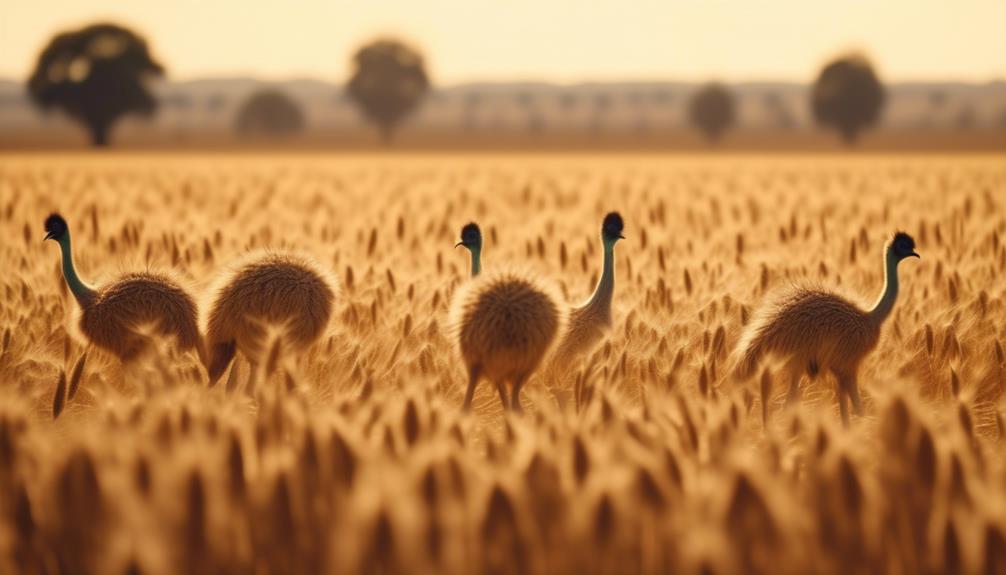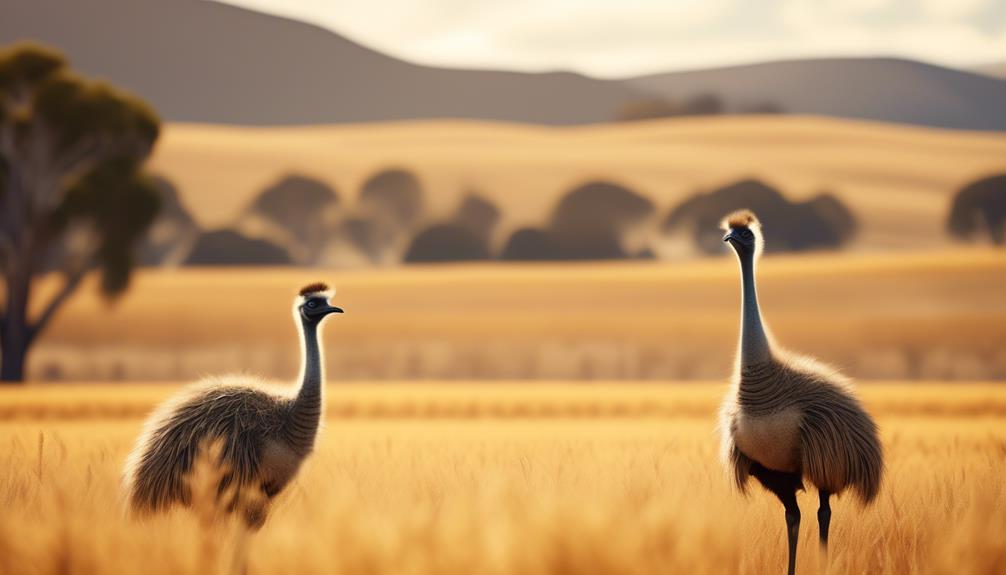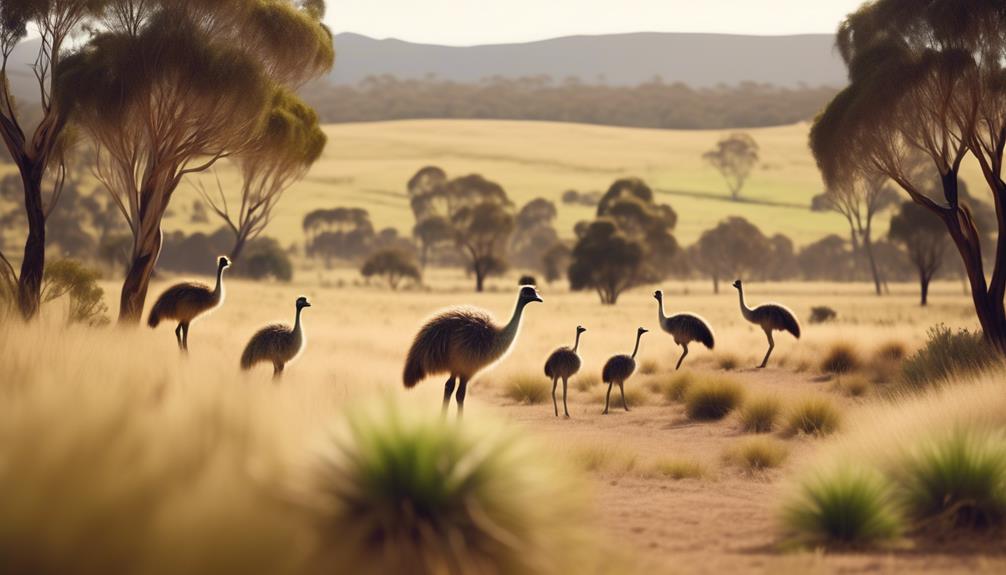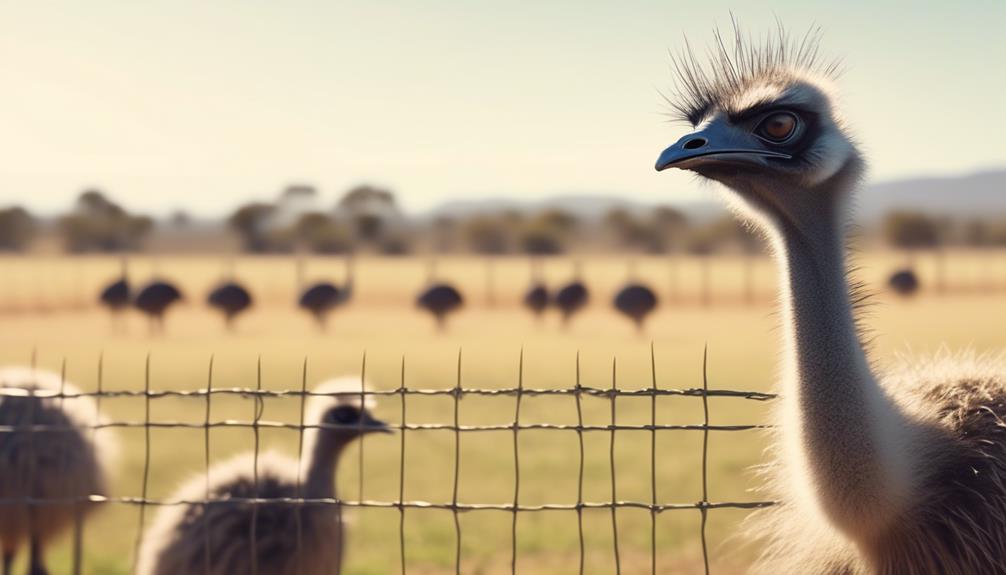
Emus, those majestic and iconic creatures of the Australian outback, are a fascinating species with a profound impact on the country's agriculture. They play a crucial role in seed dispersal and biodiversity conservation, but their presence also poses significant challenges for farmers in emu-prone areas.
As we explore the intricate relationship between emus and Australian agriculture, we will uncover the double-edged sword that comes with their influence. From crop damage to economic consequences, the impact of emus on agriculture is a complex issue that demands our attention.
So, let's journey into the world of emus and unravel the intricate tapestry of their impact on Australian agriculture.
Emus: An Iconic Australian Wildlife Species

Emus, with their distinctive appearance and fascinating behaviors, have long been revered as iconic wildlife species in Australia. These flightless birds have become deeply ingrained in Australian culture, symbolizing the unique and diverse fauna of the country. Emus are often featured in indigenous art, folklore, and traditional ceremonies, highlighting their significance in the spiritual and cultural beliefs of the Aboriginal people.
Emus also play a significant role in tourism, attracting visitors from around the world who are eager to observe these majestic creatures in their natural habitat. Australia's vast landscapes provide the perfect setting for emu-watching tours and wildlife encounters, offering enthusiasts the opportunity to learn about their behavior, habitat, and conservation efforts.
Moreover, emus have become popular mascots and symbols for various Australian organizations and events. Their distinct appearance and association with resilience and adaptability make them an ideal representation of the country's unique spirit and identity.
The Role of Emus in Seed Dispersal
With their extensive range and foraging habits, emus play a crucial role in seed dispersal within the Australian ecosystem. Emus are known to consume a wide variety of fruits and seeds, and their digestive system has evolved to effectively disperse these seeds across vast distances. This process is particularly important in the context of climate change and soil erosion.
As climate change continues to impact the Australian landscape, emus can help mitigate its effects by aiding in the dispersal of seeds. By consuming fruits and seeds from different plant species, emus effectively transport these seeds to new areas, allowing for the establishment of vegetation in response to changing climate conditions. This not only helps maintain biodiversity but also contributes to the overall resilience of ecosystems.
Emus also play a critical role in combating soil erosion. Their foraging habits involve scratching the ground with their feet, which helps loosen the soil and improve its structure. This, in turn, promotes better water infiltration and reduces the risk of erosion. Additionally, emus' seed dispersal activities contribute to the establishment of vegetation cover, further preventing soil erosion by stabilizing the soil.
Emus and Biodiversity Conservation

What is the significance of emus in biodiversity conservation efforts in Australia?
Emus play a crucial role in biodiversity conservation in Australia due to their unique characteristics and behaviors. Here are four ways emus contribute to the preservation and restoration of ecosystems:
- Seed dispersal: Emus are known to consume a wide variety of fruits and seeds, effectively acting as seed dispersers. By ingesting and later excreting viable seeds, emus help plants colonize new areas and maintain genetic diversity within ecosystems.
- Climate change resilience: Emus have adapted to withstand harsh environmental conditions, including droughts and heatwaves. As climate change intensifies, their ability to survive and thrive in these conditions makes them essential in maintaining ecosystem balance and resilience.
- Ecosystem restoration: Emus play a key role in the restoration of degraded landscapes. Their foraging behavior helps control invasive plant species, allowing native vegetation to regenerate and restore the ecological balance.
- Biodiversity maintenance: With their large home ranges, emus act as mobile links between different habitats. This movement aids in the exchange of plant and animal species, promoting genetic diversity and preventing the isolation of populations.
Emus, with their unique ecological functions, are integral to the conservation and restoration of Australia's biodiversity. Their resilience to climate change and their role in maintaining ecosystem balance make them invaluable allies in the face of environmental challenges.
Challenges Faced by Farmers in Emu-prone Areas
Farmers in emu-prone areas face a range of challenges that can impact their agricultural operations and livelihoods. These challenges stem from the presence of emus, which can cause significant damage to crops, fences, and infrastructure.
Emus are known to consume large quantities of grain and vegetation, leading to financial losses for farmers. Their strong beaks and powerful legs can also cause damage to fences, making it difficult for farmers to contain livestock and protect their fields.
In addition, emus are agile and can easily evade capture, making it challenging for farmers to control their population. The constant presence of emus can create stress for farmers, who've to constantly monitor and protect their crops. These challenges can result in decreased productivity and financial strain for farmers in emu-prone areas.
To mitigate these challenges, farmers employ various strategies such as installing emu-proof fences, implementing scare tactics, and seeking government assistance. However, these measures require significant investment of time, effort, and resources.
It's crucial for farmers in emu-prone areas to have access to support systems and resources to effectively manage the challenges posed by emus and ensure the sustainability of their agricultural operations.
Crop Damage: A Major Concern for Agriculturalists

Crop damage caused by emus poses a significant concern for agriculturalists in emu-prone areas. These large flightless birds have a voracious appetite and can quickly decimate crops if left unchecked. Here are four key points to consider regarding crop damage and the need for effective crop protection and emu deterrents:
- Extent of Damage:
Emus are known to target a wide range of crops, including grains, fruits, vegetables, and even seedlings. Their sharp beaks and powerful legs enable them to cause substantial destruction to crops, leading to significant financial losses for farmers.
- Economic Impact:
Crop damage by emus not only affects individual farmers but also impacts the agricultural industry as a whole. When crops are destroyed, farmers face reduced yields and lower profits. This, in turn, can lead to increased food prices and economic instability in the region.
- Existing Measures:
Agriculturalists have implemented various strategies to protect their crops from emus. These include the use of physical barriers such as fencing and netting, as well as the deployment of scare devices and sound deterrents. However, their effectiveness varies, and more research is needed to develop sustainable and long-term solutions.
- Innovative Approaches:
Researchers are exploring new methods to mitigate crop damage caused by emus. These include the use of chemical repellents, improved fencing designs, and the development of genetically modified crops that are less appealing to emus. Continued investment in research and development is crucial to finding effective and environmentally friendly solutions.
To safeguard their crops and livelihoods, agriculturalists must continue their efforts to find effective crop protection measures and emu deterrents. By addressing this significant concern, farmers can ensure the sustainability and productivity of their agricultural practices.
Emus and Fence Destruction: A Costly Problem
Emus, with their powerful legs and sharp beaks, can cause extensive damage to fences, creating a costly problem for agriculturalists in emu-prone areas. These majestic birds, known for their ability to jump high and their strong pecking force, can easily break through or knock down fences, resulting in the need for frequent repairs. The cost of these repairs can quickly add up, putting a financial strain on farmers and landowners.
To better understand the impact of emu fence destruction, let's take a look at the cost of repairs in different scenarios:
| Fence Type | Cost of Repairs |
|---|---|
| Traditional | $500 per repair |
| Electric | $1,000 per repair |
| Reinforced | $1,500 per repair |
| Chain-link | $2,000 per repair |
| High-tensile | $2,500 per repair |
As you can see, the cost of repairs varies depending on the type of fence used. However, regardless of the fence type, emu damage can quickly become a significant financial burden.
To mitigate the cost of repairs and address the issue at its root, emu population control measures need to be implemented. This could include implementing effective hunting programs or using non-lethal methods such as emu deterrent devices or boundary fencing. By managing the emu population, it can help reduce the frequency of fence destruction incidents and alleviate the financial strain on agriculturalists.
The Impact of Emus on Water Infrastructure

Emu fence destruction isn't the only way these majestic birds impact Australian agriculture; their presence also poses challenges to water infrastructure. Here are four ways emus affect water infrastructure:
- Water scarcity: Emus are known to consume large amounts of water, especially during breeding seasons. This can strain local water sources and contribute to water scarcity in agricultural areas.
- Damage to water infrastructure: Emus are strong and curious birds, often causing damage to water infrastructure such as pipes and tanks. This can lead to leaks and disruptions in the water supply, affecting both agricultural operations and local communities.
- Altered water flow: Emus have a habit of digging up the ground in search of food, which can disrupt natural water flow patterns. This can result in the redirection of water and the formation of new channels, potentially causing erosion and flooding.
- Impact on water quality: Emu breeding patterns can have indirect effects on water quality. Their nesting and breeding activities can lead to increased nutrient runoff into water sources, which can negatively impact water quality and aquatic ecosystems.
To mitigate the impact of emus on water infrastructure, farmers and water management authorities need to develop strategies that address water scarcity, repair and reinforce infrastructure, and implement measures to protect water quality from the effects of emu breeding patterns.
Emus and Livestock: A Potential Threat
Livestock farmers in Australia face a potential threat from the presence of emus on their properties. These large flightless birds can cause significant damage to livestock and pose challenges to livestock protection. Emus are known to trample on fences, allowing other animals to escape and cause disruptions to the farming operation. Moreover, emus have been observed to peck at young and vulnerable livestock, leading to injuries or even death.
Given these concerns, effective emu population control measures are essential for livestock farmers. One approach is the use of exclusion techniques, such as installing higher fences or using electric fencing to deter emus from entering livestock areas. Additionally, farmers can employ scare tactics, such as motion-activated lights or loud noises, to deter emus from approaching their livestock.
Collaboration between farmers, agricultural authorities, and wildlife management agencies is crucial for implementing sustainable emu population control strategies. These efforts can include targeted culling programs, where emus are selectively removed from areas where they pose the greatest risk to livestock. It's important to strike a balance between conservation and protecting the livelihoods of livestock farmers.
Emu Management Strategies: A Balancing Act

Implementing effective emu management strategies requires finding a delicate balance between conservation efforts and protecting the livelihoods of livestock farmers in Australia. To achieve this, various approaches are being explored to control the emu population while studying their behavior for better management. Here are four key strategies currently being implemented:
- Culling: Emu population control involves targeted culling to reduce their numbers. This approach aims to strike a balance between maintaining a sustainable population and minimizing the impact on agricultural activities.
- Fencing: Erecting emu-proof fences around vulnerable areas helps protect crops and livestock. These fences are designed to withstand the strength and agility of emus, preventing them from causing damage.
- Non-lethal deterrents: Emu behavior studies have led to the development of non-lethal deterrents that discourage emus from approaching agricultural areas. These include visual and auditory cues, such as scarecrows and noise-emitting devices, which help deter emus without causing harm.
- Habitat management: Understanding emu behavior and habitat preferences is crucial for effective management. By preserving or restoring natural habitats that provide suitable food and shelter, emus can be encouraged to stay away from agricultural areas.
Implementing these emu management strategies requires collaboration between conservationists, farmers, and researchers. By finding the right balance between conservation and livelihood protection, Australia can effectively manage its emu population while ensuring the sustainability of its agricultural sector.
Economic Consequences of Emu Damage
Balancing the needs of conservation and agricultural sectors in Australia extends beyond emu management strategies, as the economic consequences of emu damage pose significant challenges for farmers.
The economic implications of emu damage can have a direct impact on agricultural productivity, affecting the livelihoods of farmers across the country. Emus are known to cause damage to crops, particularly cereal crops such as wheat and barley, by trampling and eating the young plants. This can result in reduced yields and financial losses for farmers who rely on these crops for their income.
In addition to crop damage, emus can also cause damage to fences and infrastructure on farms. Repairing or replacing these structures can be costly and time-consuming, further adding to the economic burden faced by farmers. Emus can also compete with livestock for food and water, potentially reducing the productivity and profitability of livestock farming.
To mitigate the economic consequences of emu damage, farmers often employ various strategies. These may include the use of fencing, scare devices, and crop protection measures. However, these measures can be expensive and may not always be effective in deterring emus.
Emus and Agricultural Sustainability

Emus play a crucial role in the sustainability of Australian agriculture. These majestic creatures contribute to agricultural sustainability in two key ways: by preventing soil erosion and conserving water resources.
Emus and soil erosion: Emus possess strong legs and sharp claws, which allow them to dig the ground while foraging for food. This digging action helps to break up the soil, preventing compaction and enhancing its ability to absorb water. By loosening the soil, emus reduce the risk of erosion caused by heavy rainfall or wind.
Emus and water conservation: Emus have a unique adaptation that enables them to survive in arid regions with limited water availability. They can go without drinking water for extended periods, relying on the moisture they obtain from the plants they consume. This ability to conserve water is beneficial for agriculture, as it reduces the demand for irrigation and helps to maintain the water balance in farming areas.
Finding Solutions: Coexistence With Emus in Agriculture
To address the challenges posed by emus in agriculture, it's essential to explore effective strategies for coexistence with these majestic creatures. Emus have been known to cause significant damage to crops and infrastructure, leading to economic losses for farmers. However, it's important to find solutions that allow both emus and farmers to thrive.
One of the key coexistence strategies is the implementation of mitigation measures. These measures aim to minimize the negative impact of emus on agricultural activities while ensuring the preservation of their natural habitat. For example, farmers can use fencing to protect their crops from emu damage. Additionally, scare tactics such as noise-making devices or visual deterrents can be employed to discourage emus from entering agricultural areas.
Another effective strategy is the promotion of sustainable land management practices. By maintaining healthy ecosystems and preserving biodiversity, farmers can create a balance that supports both emus and agricultural productivity. This can include the establishment of wildlife corridors, providing emus with alternative habitats away from farms.
Furthermore, fostering community engagement and collaboration is crucial for successful coexistence. By working together, farmers, researchers, and government agencies can share knowledge and resources to develop and implement effective coexistence strategies. This can involve initiatives like education programs, workshops, and research projects aimed at finding innovative solutions.
Frequently Asked Questions
How Do Emus Contribute to Biodiversity Conservation in Australia?
Emus contribute to biodiversity conservation in Australia through population management and habitat restoration. By controlling emu populations, we can reduce their impact on agricultural lands while also preserving their natural habitats for other species.
What Are the Main Challenges Faced by Farmers in Areas Prone to Emu Populations?
In areas prone to emu populations, farmers face challenges like soil erosion caused by emus and the need for effective emu population control measures. These obstacles can impact agricultural productivity and require careful management.
How Do Emus Impact Water Infrastructure in Agricultural Areas?
Emus, with their large size and strong beaks, can cause damage to water infrastructure in agricultural areas. They may disrupt water management and irrigation systems, leading to potential challenges for farmers in those areas.
What Are the Potential Economic Consequences of Emu Damage to Crops?
The economic implications of emu damage to crops can be significant. Crop damage caused by emus can lead to reduced yields, increased production costs, and financial losses for farmers, impacting the agricultural sector.
What Strategies Can Be Implemented to Promote Coexistence With Emus in Agriculture?
To promote sustainable farming and coexistence with emus in agriculture, you can implement strategies like habitat modification, fencing, and rotational grazing. Additionally, emu population control measures can be used to maintain a balance between their numbers and agricultural productivity.
Conclusion
In conclusion, the impact of emus on Australian agriculture is a complex issue.
While emus play a vital role in seed dispersal and biodiversity conservation, they also pose challenges for farmers in emu-prone areas due to crop damage.
Finding a balance between emu management strategies and agricultural sustainability is crucial.
As the saying goes, 'You can't make an omelette without breaking eggs,' and similarly, coexistence with emus in agriculture requires finding solutions that address the economic consequences while respecting the importance of these iconic wildlife species.




